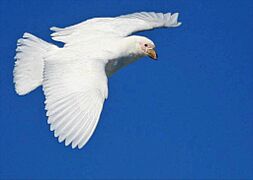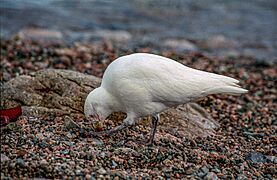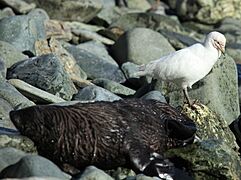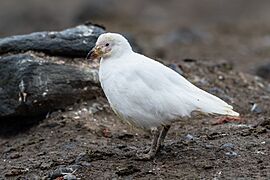Snowy sheathbill facts for kids
Quick facts for kids Snowy sheathbill |
|
|---|---|
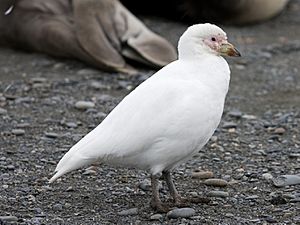 |
|
| Conservation status | |
| Scientific classification | |
| Genus: |
Chionis
|
| Species: |
albus
|
 |
|
| Synonyms | |
Vaginalis alba Gmelin, 1789 |
|
The snowy sheathbill (Chionis albus) is a unique bird. It's also called the greater sheathbill or pale-faced sheathbill. This bird is special because it's the only land bird that lives naturally in Antarctica. You'll usually find it walking around on the ground. It is one of two types of sheathbill birds.
Contents
Understanding the Snowy Sheathbill's Name
The snowy sheathbill was first officially described in 1789. A German scientist named Johann Friedrich Gmelin gave it the scientific name Vaginalis alba. He put it in a new group called Vaginalis. Gmelin based his description on notes and drawings by an English bird expert, John Latham. Latham had written about a "white sheath-bill" in 1785.
Latham thought the bird lived in New Zealand, but he was mistaken. Later, in 1912, the true home of this bird was set as the Falkland Islands. Today, the snowy sheathbill is part of the group Chionis. This group name was created in 1788 by another German scientist, Johann Reinhold Forster. The word Chionis comes from an old Greek word, khiōn, which means "snow." The second part of its name, albus, is Latin for "white." So, its name basically means "snow white bird"! There are no different types or subspecies of the snowy sheathbill.
What Does a Snowy Sheathbill Look Like?
A snowy sheathbill is about 380–410 mm (15–16 in) long. Its wings can spread out to about 760–800 mm (30–31 in) wide. This bird is completely white, just like snow. The only parts that aren't white are its face, which is pink and has small bumps. This is why its Latin name means "snow white."
These birds are quite busy! They spend most of their day, about 86%, looking for food. The rest of their time, about 14%, they spend resting.
Where Do Snowy Sheathbills Live?
The snowy sheathbill lives in very cold places. You can find them in Antarctica, the Scotia Arc, the South Orkneys, and South Georgia. If snowy sheathbills live very far south, they will fly north when winter comes. This helps them find food and stay warmer.
How Do Snowy Sheathbills Find Food?
Snowy sheathbills do not have webbed feet like ducks or penguins. This means they find all their food on land. They are omnivores, which means they eat both plants and animals. They are also scavengers, eating things that are already dead. Plus, they are known as kleptoparasites. This means they steal food from other animals!
They will eat almost anything they can find. For example, they often steal food from penguins. When penguins feed their chicks, snowy sheathbills might take the krill and fish that the penguins spit up. If they get a chance, they will even eat penguin eggs and baby chicks.
Sheathbills also eat dead animals, animal poop, and even human trash if it's available. They have even been seen eating tapeworms that came from a chinstrap penguin's stomach!
When they are actively looking for food, sheathbills spend about 38% of their day hunting. They spend 20% of their time actually eating what they catch. About 23% of their day is spent resting, and 14% is for other comfortable activities. Only a small part, about 3%, is spent on fighting or aggressive actions.
Gallery
-
This snowy sheathbill is watched carefully by a chinstrap penguin. Sheathbills can be predators of penguin chicks and eggs.
See also




